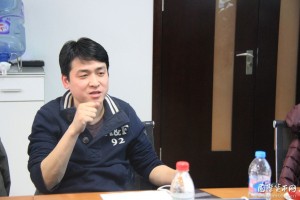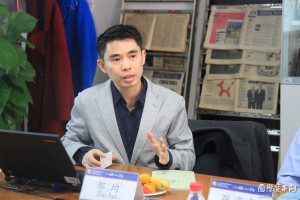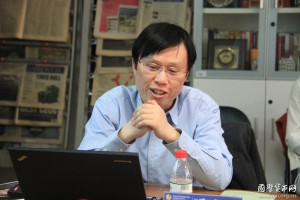IMI-Hande Fintech Salon (No. 6): Block Chain and Hyperledger
2017-03-08 IMI In his speech, Mr. Zou introduced the context, some key concepts, process, application and future of block chain in a systematic way. In his opinion, the block chain was developed under the context of three issues: internet credit, privacy and “double spend”. As for the concepts, he explained types of block chain distribution, the approach and technological core of block chain trust, namely consensus algorithm. Zou Jun believed that the development of block chain technology can be divided into three stages: the first stage is taking programmable virtual currency as the main content; the second stage emphasizes the smart contract and programmable finance, through the center of the transaction books to complete the assets of digital; the third stage is using block-chain technology to create programmable organization and society beyond the currency and economic. At the same time, he pointed out that the history of the development of the block chain is the one of the consensus algorithm. In the application of the scene, he stated that the block chain technology does not apply to all scenarios, but can be used in the financial sector, mainly for multi-party participation in transactions, non-tampering with equity registration and anti-double virtual currency and other scenes. He also gave more details by talking about specific examples such as P2P insurance, household electricity, carbon trading and land ownership. When talking about the development of the future, he held that the chain in the final analysis is indeed about the calculation, communication and storage. As the internet is entering the second half of establishing the integrity system, the chain in the future will be deeply integrated with the Internet infrastructure, law, regulation, networking and artificial intelligence, further achieving the transition from the Internet information dissemination to the block chain value.
In his speech, Mr. Zou introduced the context, some key concepts, process, application and future of block chain in a systematic way. In his opinion, the block chain was developed under the context of three issues: internet credit, privacy and “double spend”. As for the concepts, he explained types of block chain distribution, the approach and technological core of block chain trust, namely consensus algorithm. Zou Jun believed that the development of block chain technology can be divided into three stages: the first stage is taking programmable virtual currency as the main content; the second stage emphasizes the smart contract and programmable finance, through the center of the transaction books to complete the assets of digital; the third stage is using block-chain technology to create programmable organization and society beyond the currency and economic. At the same time, he pointed out that the history of the development of the block chain is the one of the consensus algorithm. In the application of the scene, he stated that the block chain technology does not apply to all scenarios, but can be used in the financial sector, mainly for multi-party participation in transactions, non-tampering with equity registration and anti-double virtual currency and other scenes. He also gave more details by talking about specific examples such as P2P insurance, household electricity, carbon trading and land ownership. When talking about the development of the future, he held that the chain in the final analysis is indeed about the calculation, communication and storage. As the internet is entering the second half of establishing the integrity system, the chain in the future will be deeply integrated with the Internet infrastructure, law, regulation, networking and artificial intelligence, further achieving the transition from the Internet information dissemination to the block chain value.
 Mr. Zhang first analyzed the core technical requirements of the commercial block chain, gave five business-friendly analysis from five dimensions——the data transparency, anonymous users, decentralization, collective maintenance, non-tampering, and explained the shortcomings of the bitcoin, the ethereum and the public chain and reasons of why they cannot meet commercial needs. He believed that the current block chain projects are hyperledger, bitcoin and ethereum. The three significantly differs in the project positioning, regulatory body and whether mining and so on. Different from decentralized bitcoins and ethereum, hyperledger should be decentralized for some parts. Zhang Haining briefly introduced the following five incubation sub-projects under the hyperledger project, of which Fabric is currently project with the most investments. He believed that Fabric is the basis of the application. Although there are some problems, but it is being improved. In the application of hyperledger, he held that only when the scene features with shared data, multiple writers, members of mutual trust, disintermediation and transaction-related characteristics, the block chain technology can be applicable. He illustrated this with examples of bank credit scenarios and the combination of supply chains and block chains.
Mr. Zhang first analyzed the core technical requirements of the commercial block chain, gave five business-friendly analysis from five dimensions——the data transparency, anonymous users, decentralization, collective maintenance, non-tampering, and explained the shortcomings of the bitcoin, the ethereum and the public chain and reasons of why they cannot meet commercial needs. He believed that the current block chain projects are hyperledger, bitcoin and ethereum. The three significantly differs in the project positioning, regulatory body and whether mining and so on. Different from decentralized bitcoins and ethereum, hyperledger should be decentralized for some parts. Zhang Haining briefly introduced the following five incubation sub-projects under the hyperledger project, of which Fabric is currently project with the most investments. He believed that Fabric is the basis of the application. Although there are some problems, but it is being improved. In the application of hyperledger, he held that only when the scene features with shared data, multiple writers, members of mutual trust, disintermediation and transaction-related characteristics, the block chain technology can be applicable. He illustrated this with examples of bank credit scenarios and the combination of supply chains and block chains.

